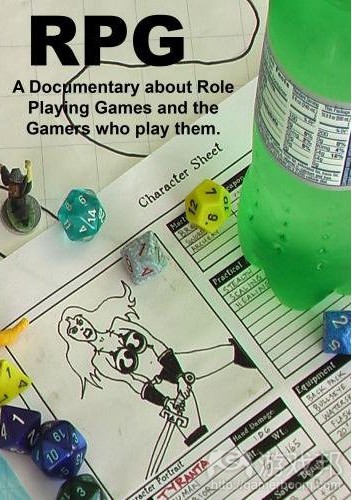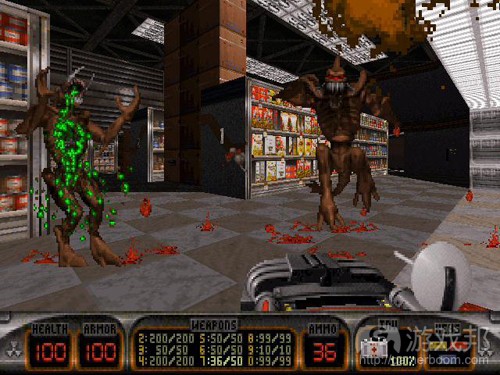阐述“RPG”特点及其“角色扮演”问题
作者:Warren Spector
对于今天的电脑RPG,你不再听到人们谈论“角色扮演”的重要性了。你听到的是,“400种职业!”、“6753种不同技能!”、“827种随从任务!”以及“这是一个大到无法探索的世界!”……省省吧。这些描述太肤浅、太愚蠢了,暴露了电子RPG来源于纸上游戏(一种与电子游戏存在危险又表面的关系的媒体)的真相。
角色扮演不是数据或探索充满立方体建筑的随机生成世界,不是每走十六步就遇到一个随机任务或遭遇战,甚至不是从背后使出双倍伤害的必杀技!角色扮演是,让玩家在一个我们提供的故事框架内自由地做出自己觉得合适的行为;是玩家做出自己的选择,以独特而有意义的方式培养自己的角色;是在安全的环境下尝试一些我们在现实生活中不能或不敢接触的事物。在此,我无法告诉你我们如何制做出这么一种允许我们做出上述行为的游戏。但我们可以通过观察角色、场景和剧情来发现并解决RPG的“角色扮演”问题。
角色
大多数RPG都把角色笼统地划分为“职业”和/或用不同的数值分类角色。角色往往有6-12种属性(游戏邦注:如力量、智力、法力等)和若干种具有不同等级的技能。骰子机制(随机数生成)决定了技能使用的成功或失败。问题是,两名玩家可以使用完全相同的东西而得到不同的结果,只因为他们的角色具有微小的差异。72级和73级这种差距不应该对玩法造成太大影响。有没有认为这样很有趣?我们必须想出一种能告诉玩家他们的角色能做什么以及为什么成功(或失败)的游戏系统。在电脑游戏中,我们不需要用42种与骰子机制捆绑在一起的技能来模拟技能使用情况。我们很聪明,我们想到了一些更好的办法——把骰子和角色属性表留给纸上玩家。
RPG通常在角色属性上大作文章。有些人认为格斗是一种更能体现角色属性的表现方式。在游戏中模拟战斗不仅容易,而且很能唤起玩家的兴奋感。但还不够。这里有一个激进的概念:当战斗发生时,把控制权给玩家。我们的目的是让战斗成为一种可选择的活动,但并非总是最好的选择,也永远不会是唯一的选择。鼓励玩家与角色之间进行非战斗性互动,特别是会话功能。
我们不可能抑制会话——因为这是一个区分角色的好工具,且强调会话功能的游戏仍然可以叫作RPG。以下是改进会话功能和玩法的三种思路:
1、会话应该反映游戏状态。没有什么比NPC被兽人砍成碎片时还在喋喋不休的现象更愚蠢了。
2、会话不应该涉及关键词。关键词不仅无聊而且无益于塑造角色。关键词是废话,可能使会话活动沦为另一个可笑的情形。
3、会话应该体现与NPC有关的事物;你的反应应该体现与你的角色有关的事物。要达到这个效果,最好的办法是在NPC互动中坚持使用“是/否”选项。例如,在一个你与善良的NPC遇到若干恶人的情景中,NPC说:“你先去做重要的事,我断后……”此时你面临的选择是:离开,那么你的NPC好友就完蛋了;留下,那么你的任务就完蛋了。这种是/否决择使这个情景变成一出与你和你的好友有关的戏剧,是非常吸引人的玩法。
只有当会话体现角色的言语、游戏世界和世界的状态(不是会话数的分支数量)时,会话才会有趣。
场景
我曾经做过一款游戏,其中玩家要花数个小时从小镇的一边走到另一边。许多流行的、备受赞誉的RPG自夸有成千上百个小镇和随机生成的任务。盲目地模拟庞大的环境并不是什么好事。给大量NPC设置会话意味着没有一个NPC的会话是有趣的。创造一个完整的国家意味着任何一座建筑都缺乏实用性。这除了增加时间和存储空间,并不能解决场景的问题。通过限制游戏世界的大小、提供若干种更小的地图以及增加互动活动,可以达成如下目标:
1、玩家即使不寻找感兴趣的事物时,也可以探索世界。漫无目的地跋涉是乐趣的大敌。
2、开发者可以通过增加角色、道具和任务来充实游戏世界,使之更加生机勃勃。
3、可以根据玩家技能来定制行为。随着玩家更加深入游戏,难度可以轻易提高。
4、开发都可以创造更丰富的场景而不是无限延伸的世界。这一点非常关键,且大多数RPG都做得不错。然而,大多数RPG的环境都直接照搬设计师的疯狂想象,经不起真实性、可识别性的推敲。我们应该留意现实世界的惯例,即使我们制作的是幻想世界。在现实世界中,你可以辨认出自己是在厕所而不是浴室,因为你可以根据空间大小、布置和摆设识别出来。游戏设计师也应该意识到这一点。
有些游戏确实体现了环境的真实性,但他们并没有走得太远。在《毁灭公爵》(这款游戏我喜欢)中,环境设计得非常逼真。玩家知道自己在电影院,可以打开放映机看穿比基尼的小妞在做什么(在这里我没有性别歧视的意思),但玩家不可能打开放映机,然后还没等对方开枪就知道有个狙击手在此。想象一下,如果射中消防栓可以让玩家熄灭火焰。《创世纪》就更进一步了,但并非总是显著的(我的过失)——关键不是每个碟子、刀子和叉子都是可用的,或者玩家收割小麦再磨成粉最后做成面包。关键是再造真实的场景和有趣的互动。给玩家一个充满可用的物品且它们能产生可预测的、有意义的结果的逼真世界吧。让他们冲破界限、冻住敌人然后消灭他们。创造一个水能破坏纸、角色能发出脚步声的世界吧。
每一个游戏问题都应该有多种解决办法,无论是通过设计还是在模拟世界中自然而然产生的另一种方案。玩家如何处理他们遇到的问题(无论他们是选择使用暴力还是开动脑筋,对话优先,武力靠后),应该影响游戏世界与他们后来的互动情况以及后来的任务内容。
剧情
是不是只有我这样觉得,似乎所有RPG都是把玩家丢进一个庞大但空洞的世界中,寄希望于他们“自己去寻找一些乐趣”?作为游戏开发者,我一直觉得对不起玩家。在游戏世界中游荡了几个小时,玩家甚至只是在寻找让他们杀死恶魔Foozle的线索。这几乎就像存在什么不可言说的规则,禁止向RPG玩家透露明确的目标。这种诡计不应该是让玩家想出自己应该做什么(这并不好玩),而是想出如何完成你认为自己应该完成的事。随着你的行动过程,你会发现新目标。使这些目标更有趣一些吧,不应该是“杀死你见到的任何敌人”,对吧?在与Richard Garriott共事的日子里,我学到的是,RPG可以不仅仅是激烈的斗殴。游戏超越其他媒体的地方在于,它让玩家找面对难题时找到自己的答案,而不是把设计师的观点强加给玩家。我们探究什么问题并不重要,忍耐、道德、关系,无论是什么主题,只要让我们能探索一些东西就行了。
《地下城爬行者》好就好在,允许玩家探索自我和自己的信念。不像小说家或导演,游戏开发者给玩家机会去体验他们在现实生活中从未尝试过的行为。我认为这也是游戏开发者的职责所在。如果我们只给出唯一的答案(通常是通过暴力解决问题),那么我们不仅伤害了我们的玩家,也破坏了我们的游戏。
允许玩家做选择,然后显示这些选择的不同结果:见一个杀一个然后承担后果;扮演和平主义者然后付出另一种代价。游戏应该提供道德困难,而不是单纯的对错选项。“你为什么战斗?”和“你如何达到目标?”应该是不可避免的问题。当所有这些都完成了,剧情目标和难题就只是用于吸引玩家的工具了。如果我们制作一个小型的、深刻的、目标丰富的模拟世界,允许用不同的方式解决难题,玩家就必然会发现RPG的“真正的”目标——培养独一无二的第二个自我。
按照我上述所说的去做,绝不能保证你的游戏会获得成功或收获来自同行、新闻媒体和玩家的赞誉。我知道的只是,我们努力过了。虽败犹荣。如果我们满足于制作五年十年以前就存在的那种RPG和模仿这几年来出现的所有RPG的那种RPG,那么我们就完蛋了。(本文为游戏邦/gamerboom.com编译,拒绝任何不保留版权的转载,如需转载请联系:游戏邦)
Warren Spector: Who forgot the ‘role’ in Role-Playing Games?
By Warren Spector
The oddest thing about computer role-playing games today is that you never hear anyone talk about the importance of playing a role. You hear about “400 character classes!” “6,753 unique skills!” “827 errand boy missions!” and “A world so big you won’t want to explore it all!” Give it a rest. This is shallow. It’s silly. It betrays our geeky roots in paper gaming (a medium with only a dangerous, superficial relation to electronic gaming).
Role-playing isn’t about statistics or exploring randomly generated worlds of crate-filled buildings. It isn’t about random quests and combat encounters every sixteen steps. It isn’t even about +37 Swords of Instant Critical Hits that do Double Damage From Behind! Roleplaying is about giving players the freedom to act as they see fit, within the framework of a story we provide.
Role-playing is about characters developing in unique and meaningful ways as a result of player choices. It’s about trying new behaviors in a safe setting before we try them in the real world. In the space I have here, I can’t tell you how we make a game that allows us to do all that. But let’s start by identifying problems, and by looking at character, setting, and story, and how we usually approach them.
Character
Most RPGs define characters by an arbitrary “class” and/or a tiresome list of statistics. Characters typically have 6-12 attributes (strength, intelligence, and so on) and dozens of skills tracked at a fine level of granularity (lockpick score of 12, sharpshooter 72, computer hacker 53). Secret die rolls determine success or failure in skill use. The problem with this is that two players can do exactly the same thing and get different results because of insignificant differences between their characters. The difference between a 72 and a 73 shouldn’t have any impact on game play. Does anyone think this is fun? We have to come up with game systems that tell players what their characters are capable of doing and why they succeeded (or failed). In a computer game, we don’t need 42 skills tied to percentile die rolls to simulate skill use. We’re clever. We can come up with something better. Leave the dice and character sheets to paper gamers.
RPGs often use characters’ abilities to bake bread, charm NPCs, and so on. Yawn. Some think hack-and-slash is a more riveting way to use characters’ attributes. Ah, combat! It’s relatively easy to simulate and it gets adrenaline pumping. That’s not enough. Here’s a radical concept: let players control when and if combat happens. Our goal should be to make combat an option, but not always the best, and never the only one. Encourage noncombat interactions, especially conversation.
We can’t compromise conversation — a terrific tool for differentiating characters — and still call a game an RPG. Here are some ideas for improving conversations and game play:
Conversations should reflect game state. Nothing’s goofier than NPCs who keep talking while orcs hack them to bits.
Conversations should not involve lists of keywords. They’re not fun, nor are they revealing of character. They’re filler. They reduce conversations to the status of another stupid puzzle.
Conversations should reveal things about NPCs; your responses should reveal things about you. The best way to accomplish this is to make “Yes/No” options the rule in conversational interaction with NPCs. Take, for example, a situation in which you and a friendly NPC face several enemies. The friend says, “I’ll hold them off while you escape and Do Important Things…” Leave, and your friend is doomed. Stay, and your mission may come to an end. A Yes/No decision becomes a dramatic moment that reveals something about your friend and about you. That’s very compelling game play.
Conversations are made interesting by the things they reveal about the characters speaking, the game world, and the world’s state — not the number of branches in a conversation tree.
Setting
I’ve worked on games in which it takes hours to walk from one side of town to the other. Many popular, award-winning RPGs boast of hundreds of generic towns and randomly generated quests. The shallow simulation of huge environments isn’t a good thing. Providing dialogue for scads of NPCs means none of them has anything interesting to say. Creating an entire country means any single building will be devoid of useful objects. It’s a matter of time and storage space, and no amount of whack-on-the-side-of-the-head thinking allows you to finesse your way around the problems. Limit the size of your world. Provide several smaller maps. Increase the density of interaction. This accomplishes several goals:
Players can explore without searching for something exciting to do. Aimless wandering is the enemy of fun.
Developers can populate the world more densely with characters, objects, and quests, and give the illusion of a place with a life of its own.
Action can be tailored to player skill. Difficulty can be increased easily as players get deeper into the game.
Developers can create more varied locations than in a sprawling world. This last point is critical, and most RPGs do this well. However, most RPGs feature wacky environments straight out of designers’ fevered imaginations. It’s not asking too much to think in terms of believable, recognizable locations instead of arbitrary game spaces. We should try to acknowledge the conventions of the everyday, even when we create fantasy worlds. In the real world, you can tell you’re in a bedroom, as opposed to a bathroom, the instant you enter because of size, placement, and furnishings. More game designers should realize this.
Some games do hint at the possibilities of believable environments, but they don’t go far enough. In Duke Nukem (a game I loved), the environment was a gimmick. You knew you were in a movie theater, and you could switch the projector on and watch a bikini’ed babe do her thing — let’s talk about sexism another time — but you couldn’t switch on that projector and blind a sniper before he fired. Imagine if shooting a fire hydrant allowed you to douse a fire. The Ultima games go further, but not always in significant ways (mea culpa!) — the key is not that every plate and knife and fork be usable, or that players reap wheat, grind it into flour, and bake it into bread. The key is recreating realistic locations and object interactions that are exciting. Give players believable worlds with lots of usable objects that produce predictable, useful results. Let them blast barricades, freeze enemies and then shatter them. Create worlds where water damages paper and gratings creak beneath players’ feet.
Every game problem should have multiple solutions, by design or because alternatives arise naturally out of the simulation. How players deal with the problems they encounter (whether they choose violence over cleverness, talk first and shoot later, and so on) should affect subsequent interactions with the denizens of the game world as well as the substance of later missions.
Story
Is it just me, or does it seem like every RPG drops players into a huge, all-but-empty world and says, “Go. Hope you find some fun.”? Man, have I been guilty of that. After stumbling around for a couple hours, players may even find a clue that they’re supposed to Kill the Evil Foozle. It’s almost as if there’s some unspoken rule against offering RPGers clear goals. The trick shouldn’t be figuring out what you’re supposed to do (which isn’t much fun); the trick should be figuring out how to accomplish what you know you have to accomplish. New goals can be revealed as you go, but damn it, reveal those goals! And make those goals more compelling than “kill everything you see,” okay? If working with Richard Garriott taught me anything (and, believe me, it did) it’s that an RPG can be more than just a slugfest. More than any other medium of expression, gaming lets people find their own answers to tough questions, rather than imposing an artist’s vision of the world on them. It doesn’t matter what issues we explore — tolerance, morality, relationships, whatever — but let’s explore something.
Dungeon crawls are all well and good, but we can allow players to explore who they are and what they actually believe. Unlike authors and filmmakers, we can give people the opportunity to test behaviors they’d never try in the real world. I feel we have an obligation to do that. If we provide only one answer (usually violent) we do our medium and our players a disservice.
Allow players to make choices and then show the ramifications of those choices: kill everything you see and suffer the consequences; play the pacifist and pay a different price. Games should be rife with ethical dilemmas rather than right and wrong choices. “What are you fighting for?” and “How do you achieve your goals?” should be unavoidable questions. When all is said and done, story goals and tough questions are just tools used to suck in players. If we create small, deep, object-rich simulations that allow multiple solutions to tough problems, players will inevitably stumble upon the “real” goal of an RPG — to grow a unique alter ego.
Doing everything I’ve outlined above won’t assure you a hit and accolades from peers, press, and players. All I know is we have to try. We have to fail gloriously. If we keep settling for RPGs that could have been made five or ten years ago — and that describes every RPG released in the last couple of years — we’re doomed.(source:gamasutra)
上一篇:写给音效师求职新人的几条建议
下一篇:分析手机应用功能日趋同质化的原因









































 闽公网安备35020302001549号
闽公网安备35020302001549号